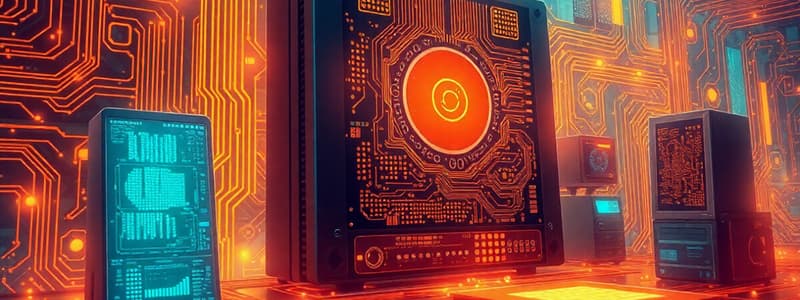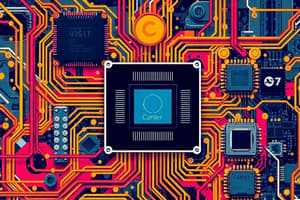Podcast
Questions and Answers
Which cloud service type is designed primarily for developing and deploying applications?
Which cloud service type is designed primarily for developing and deploying applications?
- Software as a Service (SaaS)
- Infrastructure as a Service (IaaS)
- Platform as a Service (PaaS) (correct)
- Desktop as a Service (DaaS)
What is NOT considered a common cybersecurity threat?
What is NOT considered a common cybersecurity threat?
- Phishing attacks
- Denial-of-service (DoS) attacks
- Lightweight Directory Access Protocol (LDAP) attacks (correct)
- Data breaches
Which security measure is primarily used to prevent unauthorized access to networks?
Which security measure is primarily used to prevent unauthorized access to networks?
- User authentication (correct)
- Data encryption
- Backup systems
- Antivirus software
Which technology connects devices to facilitate data exchange?
Which technology connects devices to facilitate data exchange?
What is a primary benefit of big data analytics?
What is a primary benefit of big data analytics?
What is the primary function of the Central Processing Unit (CPU) in a computer?
What is the primary function of the Central Processing Unit (CPU) in a computer?
Which of the following is an operating system?
Which of the following is an operating system?
What is the purpose of a Network Interface Card (NIC)?
What is the purpose of a Network Interface Card (NIC)?
Which type of network connects devices over a large geographic area?
Which type of network connects devices over a large geographic area?
In data management, what role do databases play?
In data management, what role do databases play?
What is a key benefit of cloud computing?
What is a key benefit of cloud computing?
Which component is involved in the construction of software?
Which component is involved in the construction of software?
Data integrity ensures that the data remains:
Data integrity ensures that the data remains:
Flashcards
Infrastructure as a Service (IaaS)
Infrastructure as a Service (IaaS)
Provides the basic building blocks for your computer system, like servers, storage, and networking. Imagine renting the raw materials to build a house, then using them to construct your own home.
Platform as a Service (PaaS)
Platform as a Service (PaaS)
Offers a complete platform for developing and deploying applications, including tools, frameworks, and runtime environments. It's like renting a pre-built house with all the necessary utilities and appliances.
Software as a Service (SaaS)
Software as a Service (SaaS)
Delivers software applications over the internet, allowing users to access them from any device with an internet connection. Imagine using an online service, like email or word processing, without needing to install any software.
Cybersecurity
Cybersecurity
Signup and view all the flashcards
Internet of Things (IoT)
Internet of Things (IoT)
Signup and view all the flashcards
What is the CPU?
What is the CPU?
Signup and view all the flashcards
What is RAM?
What is RAM?
Signup and view all the flashcards
What is an Operating System?
What is an Operating System?
Signup and view all the flashcards
Describe application software.
Describe application software.
Signup and view all the flashcards
What is a LAN?
What is a LAN?
Signup and view all the flashcards
What is a WAN?
What is a WAN?
Signup and view all the flashcards
What is a database?
What is a database?
Signup and view all the flashcards
What is cloud computing?
What is cloud computing?
Signup and view all the flashcards
Study Notes
Introduction to Information Technology
- Information technology (IT) encompasses the tools, techniques, and processes used to manage, store, retrieve, and process data.
- It is a broad field encompassing various software and hardware components.
- IT systems are crucial for businesses, organizations, and individuals to operate efficiently and effectively.
Hardware Components
- Computers and related devices form the foundation of IT infrastructure.
- Key hardware components include:
- Central Processing Unit (CPU): The "brain" of the computer, performing calculations and instructions.
- Random Access Memory (RAM): Stores data and instructions currently in use.
- Hard Disk Drive (HDD) and Solid State Drive (SSD): Permanent storage for data.
- Motherboards: Connects all components together.
- Input devices: Keyboard, mouse, scanner, microphone.
- Output devices: Monitor, printer, speakers.
- Network Interface Card (NIC): Enables computers to connect to a network.
- Peripheral devices expand computer capabilities.
Software Components
- Software dictates how hardware functions.
- Types of software include:
- Operating Systems (OS): Manage computer resources (e.g., Windows, macOS, Linux).
- Application Software: Performs specific tasks (e.g., word processors, web browsers, games).
- Programming Languages: Allow developers to create software (e.g., Python, Java, C++).
- Software development life cycles (SDLC) are crucial for creating and implementing new software.
Networking
- Networking connects computers and devices to share resources and communicate.
- Types of networks include:
- Local Area Networks (LANs): Connect devices within a limited geographic area.
- Wide Area Networks (WANs): Connect devices across a large geographic area (e.g., the internet).
- Protocols like TCP/IP govern data transmission over networks.
- Network security is paramount to protect data and systems from unauthorized access or damage.
Data Management
- Data management involves organizing, storing, and retrieving data.
- Databases are used to structure and manage large amounts of data.
- Database management systems (DBMS) are software systems that manage databases.
- Data integrity ensures that data is accurate and reliable, with appropriate protocols in place.
Cloud Computing
- Cloud computing delivers computing resources (servers, storage, software) over the internet.
- Offers scalability, flexibility, and cost-effectiveness.
- Types of cloud services include:
- Infrastructure as a Service (IaaS): Provides basic computing resources.
- Platform as a Service (PaaS): Offers a platform for developing and deploying applications.
- Software as a Service (SaaS): Delivers software over the internet (e.g., webmail, online office suites).
Cybersecurity
- Cybersecurity protects computer systems and data from threats.
- Threats include:
- Viruses, malware, and ransomware
- Phishing and social engineering attacks
- Denial-of-service (DoS) attacks
- Data breaches
- Security measures include:
- Firewalls
- Antivirus software
- User authentication
- Strong passwords
- Data encryption
Emerging Technologies
- Several technologies are shaping IT's future.
- Artificial intelligence (AI) and machine learning (ML) are transforming various applications.
- Internet of Things (IoT) connects devices and facilitates data exchange.
- Big data analytics processes vast amounts of data to extract insights.
- Blockchain offers secure and transparent data management.
Studying That Suits You
Use AI to generate personalized quizzes and flashcards to suit your learning preferences.




